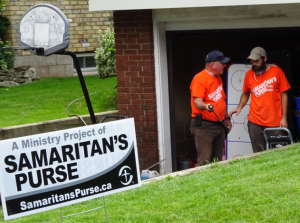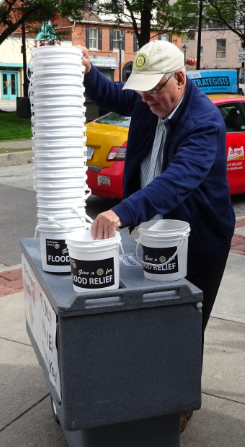 By Pepper Parr
By Pepper Parr
September 3, 2014
BURLINGTON, ON
Part 1 of 3 parts
The rain just poured.
The city manager was away for what was a long weekend for everyone; Pat Moyle didn’t learn about how bad things were until he went into town the following day – the Tuesday and learned that Burlington was in the middle of a disaster much bigger than the December ice storm.
He was at his cottage celebrating his Father’s the 90th birthday; within hours he was on his way back to Burlington – in a hurry.
People in Burlington were stunned. There was basically nothing in the way of communication from the city until well into Tuesday. People were talking to people; those in wards four and five had been through this before, some more than once before – but much of the rest of the city had not experienced this kind of weather.
Aldershot was basically spared while the council member for Ward 3 made the very inconsiderate remark that he had some “repeat customers”
Councillor Meed Ward – ward 2 said later that there was very little damage in her ward – which didn’t stop her from getting things going, making phone calls and looking for ways to help out.
 By the end of Tuesday it was clear that the city was in the middle of a serious disaster. CHCH television in Hamilton took up the story and there was a lot of tweeting – but if you’re not part of a tweet string – you’re out of the loop. There was no central source of information.
By the end of Tuesday it was clear that the city was in the middle of a serious disaster. CHCH television in Hamilton took up the story and there was a lot of tweeting – but if you’re not part of a tweet string – you’re out of the loop. There was no central source of information.
The Region began promoting their 311 service at which people could report the extent of the damage to their homes. This was the collecting of information – which was critical data, the city needed to quantify the damage in order to make its case for support to the province – but none of that meant all that much to the people whose basements were under water and people were still in that “stunned” stage with water as high as their knees.
By Wednesday the Red Cross had people out on the street trying to get a sense as to just how bad the damage was. Before they were done their work they had knocked on more than 10,000 doors

The Samaritan’s Purse was first out into the community helping. They understood what disasters were all about – they came to Burlington to help.
Meanwhile the Samaritan’s Purse had people in homes working at cleaning up the mess. By the end of the first week they had restored more than 35 homes.
The city held a press conference – more for TV than anything and then held a community meeting in one of the harder hit parts of town. That event was exceptionally emotional and very uncomfortable for those from the Region. Regional chair Gary Carr is reported to have not wanted to even attend the event.
Mayor Goldring was exceptional at this event. The compassion people needed was there; the mayor, who was also flooded, listened and responded in a way that few have seen in him before. Deep down he is a bit of a softy – and that was what people needed at that point.
City hall was scrambling to determine what they could do. They knew a little about the Ontario Disaster Relief Assistance Program (ODRAP) which has two parts; funds made available to a municipality for damage done and funds made available to individuals. Burlington put in a request for funds as a result of the December ice storm – no money from the province on that one yet.
The public part of the ODRAP program requires a municipality to create a local Disaster Relief Committee. It took Burlington close to a month to get that committee in place. The city first had to pass a motion at Council asking the province to declare the city a disaster area. That happened August 14th – ten days after the flood.

The early objective was to tell the stories as widely pas possible using every media available. A T-shirt was as good as a television screen
The province has yet to actually declare Burlington a disaster area. What was evident to thousands of people in the city, wasn’t as cut and dried (no pun intended) to the province.
Burlington had gone after the public part of the program for the winter ice storm; they have yet to see any of that money. Getting money that would go into the hands of people harmed by the disaster was something city hall was not up to speed on.
Mayor Goldring then began to reach out to community partners for the help needed. He touched the Burlington Community Foundation (BCF) to take on the leadership role of creating the local Disaster Relief committee. BCF president Colleen Mulholland took the lead on that even through her own home had been badly flooded.
It took a little longer than many expected to get the basics of the Disaster Relief Committee in place and name a chair – that was supposed to happen on the 27th of August but got pushed back a day. All the public saw was a terse announcement naming Ron Foxcroft as the chair.
Foxcroft was to lead the fund raising side while former city manager Tim Dobbie was to handle the dispersement of the funds that were raised.
Goldring got on to the Burlington/Hamilton United Way and asked them to accept donations for the Disaster Relief fund. Newly appointed United Way head honcho Jeff Valentin, took on that challenge and had a portion of the United Way website set up to receive donations.
Problem was that the flood restricted itself to water and sewage – there wasn’t that much money flowing to the fund even though there were several large donations in the first few days. Newalta stepped up very quickly with $10,000 and the BCF put $15,000 of their money on the table to which CUPE added $10,000.
Before the start of the Labour Day weekend there was just over $150,000 in the account – to be fair there is thousands of dollars from different groups working its way to the account.

A Rotarian stacks the buckets that were used during Ribfest to hustle as much as possible from a potential audience of 150,000 +
Goldring then reached out to Linda Davies, president of the Lakeshore Rotary – and asked if they would use Ribfest as a fund raising event. Davies got on the telephone and within hours had a buy in from all four Burlington Rotary organizations and then displayed the plastic buckets that would be used to collect twoonies and paper money, if people were so inclined, at the Ribfest kick off.
Things were coming together very well on the fund raising side – at least the potential is there for all to see. The proof of course is in the pudding and we’ve not seen that yet.















